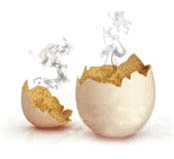
Sulfur mineral itself has no scent. The odor of rotten eggs actually comes from hydrogen sulfide (H2S) which is a by product of sulfur - it can be produced in water (including humidity in the air). Volcanoes and hot springs could produce H2S via the hydrolysis of sulfide minerals. The odor can be detected at 2 parts per bilion (ppb).
Ninety-five percent of pollution related sulfur oxide emissions are in the form of sulfur dioxide (SO2), a heavy, colorless gas with an odor like just struck matches.
Most thiols (compounds containing an SH functional group) smell like variations on garlic or skunk. Sulfides have the structure R-S-R′, and are therefore the sulfur analogues of ethers. Hydrogen sulfide smells like 'rotten egg', while Dimethyl sulfide has a smell that is usually described as 'rotting cabbage', 'cooked cauliflower' or just plain 'unpleasant. Dimethyl Disulfide smells like rotting meat. Methanethiol (or methyl mercaptan - CH3SH) smells like rotten cabbage or urine after eating asparagus.
Sulfur-reducing bacteria, which use sulfur as an energy source, are the primary producers of large quantities of hydrogen sulfide. These bacteria chemically change natural sulfates in water to hydrogen sulfide. Staphylococcus and Corynebacterium spp. are the most abundant organisms colonizing moist areas of the body and emitting sulfury odors.
|
|
